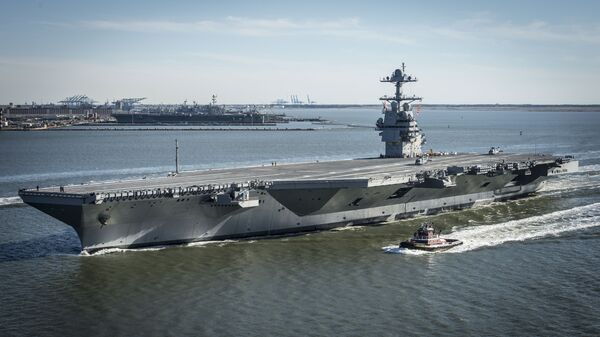The Navy claims the problems with landing the planes have been fixed, but another issue that’s perhaps more important remains unresolved: Super Hornets with full tanks of fuel cannot launch from the carrier, either, "a handicap that could limit their effectiveness in combat," Bloomberg noted.
Reworking the landing systems forced the Navy to spend more than three times what it had budgeted for the mechanism, according to documents obtained by the news service. The final expenditure of $961 million blew the expected outlay of $301 million out of the water.
On Wednesday, Sputnik reported on the Navy’s attempt to accelerate development of a MQ-25A Stingray drone that could supply extra fuel to Super Hornets during missions. But the Stingray is still two years out from taking off on Super Hornet sorties, even if it matches the Navy’s ambitious timeline. As many as 25 to 30 percent of Super Hornets taking off from US carriers are flying fuel resupply missions, which might be a suboptimal solution considering the jets weren’t designed as tankers.
If the electromagnetic launch mechanism — berated by US President Donald Trump as “no good” — continues to pose problems for the Ford, it could foreshadow more cost overruns and schedule delays for two more Ford-class carriers requested by Trump and the Navy.
One Arizona senator scoffed at the possibility that the next two ships will be built on time and on-budget. Senator John McCain also pointed out that the request for the third Ford-class carrier is mysteriously $1.6 billion higher than the USS Gerald Ford.
“This is unacceptable for a ship certified to be a repeat design,” McCain said. “The Ford-class program is currently estimated to be more than $6 billion over budget,” once all three carriers are manufactured, tested and delivered to the Navy, according to a white paper from McCain’s press office.
The second ship of the Ford-class is “five years behind schedule,” according to the white paper dubbed “America’s Most Wasted.” The business case for the Ford carriers was in good standing when it began, but “it has deteriorated in the face of persistent technology immaturity that led to concurrency is system development, construction and testing.”
Of course, this was “all made worse by cost and schedule estimates that had little margin for error.”
Insufficient competition among contractors, excessive concurrency of development and testing activities, risky contracting practices and overly optimistic initial cost estimates have contributed to the Ford’s costly — and growing — tax bill to Americans, according to reports from the Government Accountability Office.






